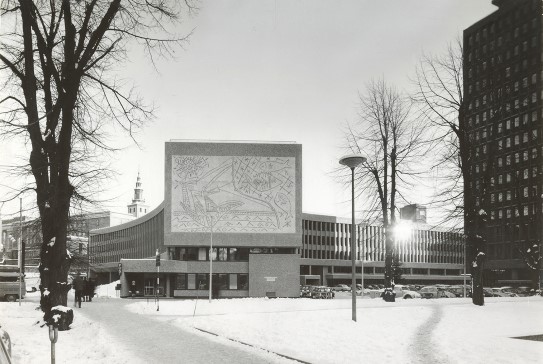Erling Viksjø’s buildings challenge many people’s concept of what good architecture is. Highly innovative, he forged a unique working relationship with several artists. Art became a part of the architecture itself.
Erling Viksjø (1910–1971) was one of Norway’s most influential architects in the post-war period, well known for his concrete architecture and high-rise buildings. This exhibition examines his extensive collaboration with artists such as Carl Nesjar, Pablo Picasso, Hannah Ryggen, Inger Sitter, Synnøve Anker Aurdal, Kai Fjell, Tore Haaland, Ramon Isern, Odd Tandberg and Jakob Weidemann.
Concrete in Transition provides insight into how Viksjø worked with these artists on projects such as the Government Quarter in Oslo, the Norsk Hydro administration building, the Elkem building, the office building for Standard Telefon- og Kabelfabrik, the Oslo Board of Public Health building and Bakkehaugen Church.

Erling Viksjø
- Born 4 July, 1910, in Trondheim, Norway
- Education: Norges Tekniske Høyskole (Norwegian Technological College).
- Employed and later lead architect at Ove Bangs architectural office.
- Formed his own architectural firm after World War II
- Prisoner at Grini prison during parts of WWII.
- Influenced by Le Corbusier og Marcel Breuer.
- Extensive use of concrete in his designs. Sandblasted concrete, conglobetong, and concrete with carefully placed rock patterns are among Viksjøs trademarks.
- Key projects: Bakkehaugen Church (1939-59), the Hydro Building (1955-63), the Government Quarter (Y-blokka, 1952-69 and Høyblokka, 1946–59), and Oslo Board of Public Health (1956-69).
- Viksjø died 2 December 1971 in Oslo, Norway
Read more and see more works by Erling Viksjø in the online collection.
The Government Quarter
Viksjø’s first major architectural commission was Høyblokka in the Government Quarter. The project was an ambitious experiment on the part of the young architect, not only with regard to the use of materials and techniques, but also in how he, as an architect, collaborated with artists on such a colossal project.
Høyblokka was lavishly decorated with sand-blasted wall decoration by Haaland, Nesjar, Sitter and Tandberg, among others, all of whom worked within an abstract style. Viksjø also employed Kai Fjell and textile artist Hannah Ryggen. The latter created the monumental tapestry We Live upon a Star (1958) for this project.
Find out more about Hannah Ryggen and her works in the online collection.
Picasso
The Government Quarter marked the beginning of a long-lasting collaboration between Viksjø, Nesjar and Picasso. One reason for the vigorous protests sparked by the demolition of the “Y-block” of the Government Quarter was that the building had been decorated with Picasso’s motifs The Fishermen and The Seagull. These artworks were integrated into the walls as murals, and could thus not be separated from the building itself. The exhibition also presents other lesser-known projects on which Viksjø, Nesjar and Picasso collaborated, including a museum project in Kiruna, northern Sweden.
Experiments in concrete
In addition to collaborating with artists, Viksjø also worked with engineers to develop new materials and techniques. This resulted in a variety of new concrete products that Viksjø called Naturbetong (natural concrete), conglo concrete and metal concrete.
The exhibition casts light on Viksjø’s collaboration with Odd Tandberg and their experiments with conglo. This colourful and distinctive style evokes associations with the abstract painting of the time. The conglo technique was used for the façades of large-scale construction projects such as the Norsk Hydro administration building, as well as in various types of tables.
Viksjø as an artist
Viksjø’s experience as a painter is not widely known. While imprisoned in Grini prison camp during World War II he became acquainted with several inspiring artists, including Hans Ryggen. The exhibition shows a selection of Viksjø’s own paintings from the periods during and after Grini. These pictures display Viksjø’s early experimentation with techniques and expressions, which would become a key element of his later work with paintings and construction projects.